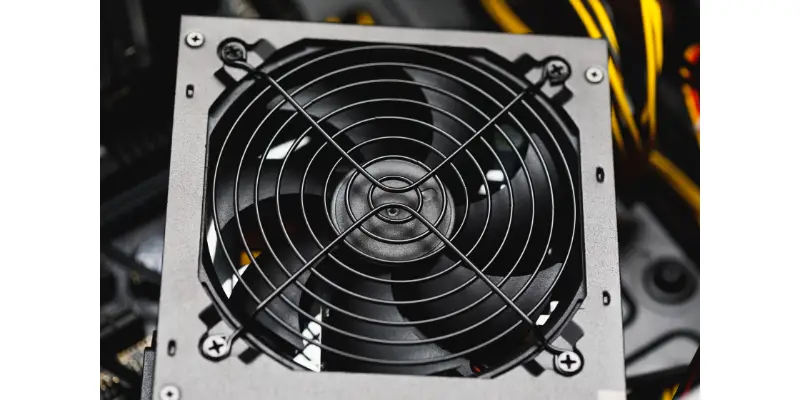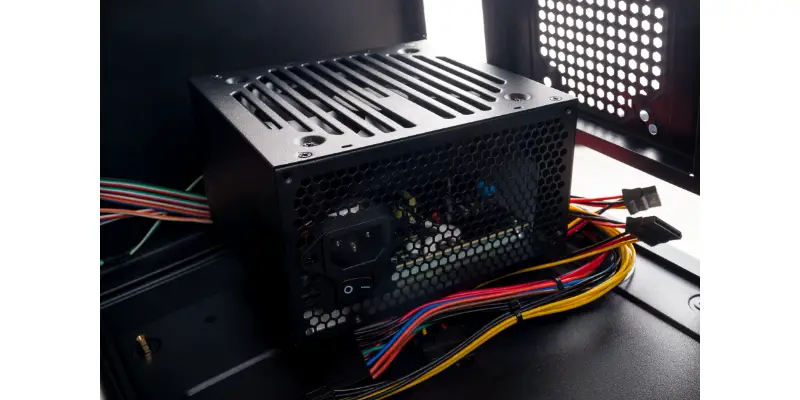Disclaimer: This post may contain affiliate links, meaning we get a small commission if you make a purchase through our links, at no cost to you. For more information, please visit our Disclaimer Page.
Sometimes our PSU just can’t provide enough power. It happens to the best of us. You’ve got a beefy system with all the high-end hardware and a PSU that just can’t keep up. So what happens when it’s too weak?
The power supply unit (PSU) is one of the essential components of a computer. If it’s underpowered or too weak, it can cause several different problems to your system, such as random program crashes, unexpected shutdown & restart, system freezes, video errors, complete shutdown, and the blue screen.
Table of Contents
What Will Happen If PSU Is Too Weak?
The power supply unit (PSU) is an internal hardware component that helps the computer to convert the alternating high voltage current (AC) into direct current (DC). PSUs also help regulate the DC output voltage, keeping modern computing components from overheating.
Furthermore, you need to understand that the power supply unit of a system plays one of the most important functions. It’s safe to say that your system is nothing without a PSU. Matter of fact, there are hardly any components in your computer system that do not need the PSU.
For instance, your computer’s graphics card is the component that requires power the most. Without a good power supply unit, there’s no way the hardware component can work to deliver you the best gaming experience. That’s not all; in the absence of a working PSU, there’s no way you can power your system.
Is a weak PSU dangerous?
So, let’s return to this post’s burning question – what will happen if your system’s power supply unit is too weak? The answer to the question is simple; with a weak PSU, your system will not get the best wattage to perform up to expectations.
The primary function of the PSU, as earlier mentioned, is to convert the alternating high voltage current from your electricity to DC. With that, it means PSU is the first place to receive electricity. As we all know, electrical currents aren’t always stable – they fluctuate a lot.
And it’s only a strong and reliable PSU system that can handle the unstable current and convert it to the much-needed DC with a well-regulated output voltage.
As such, if the PSU is weak, many things could happen, depending on how much wattage it can deliver.
A weak PSU is often underpowered, and since that’s the case, it’ll surely not have the capability to convert and deliver enough wattage to other components of your computer. And when this happens, it could bring about several different issues.
Let’s have a look at some of the outcomes of having a weak PSU below:
System’s failure to start
One of the many issues you’ll experience if the power supply unit is weak is that your system will fail to come up. In case you don’t know, computer systems are designed such that when they’re not receiving enough power they’ll fail to work.
So, if your power supply unit is weak, the amount of power it’s able to convert and deliver to your computer is what will determine whether or not the system will come up.
If the power isn’t enough, the computer will not come up. Even if it manages to start, it’ll most likely display and show a splash screen, which certainly won’t last long.
Graphics downgrade
Depending on how weak the power supply unit is, another issue that you will likely experience is graphics downgrade.
As earlier mentioned, the computer’s graphics card is the most power-hungry component of a PC. It can consume a lot of power depending on what you use it for.
That said, if your power supply unit is weak, there’ll certainly be a limit to the amount of wattage it’ll be able to offer the system. With an underpowered graphics card, what you’ll achieve is low-quality graphics.
Unexpected or random shutdowns
Another issue that’s associated with using a weak PSU is that you’ll often experience random shutdowns – this could happen in the middle of something important.
Furthermore, you need to understand that the issue of random shutdowns of the system depends on how weak the power supply unit is.
The PSU may have enough power for the system but as soon as you start using it to, let’s say start mining Bitcoin, it becomes inadequate and weak, leading to random shutdowns.
That said, other possible issues that you may encounter when the power supply unit is weak include the following:
- Display issues
- Blue screen of death
- Smoke formation from the PSU fan
- Unstable system
Will Upgrading PSU Improve System Performance?
Now that you’ve seen some of the likely issues that weak power supply units can cause, the next question is what is the way forward?
I have seen some people suggesting that a good solution to improve the system’s performance is to upgrade the power supply unit. But how effective is that? Will upgrading PSU help to improve the performance of your computer?
Let’s face it; unless you’re using a weak power supply unit, it’s unlikely that upgrading the PSU will increase your system’s performance. The work of the PSU is to convert AC to DC and deliver a well-regulated DC output voltage to the computing components. So, if you already have a powerful PSU, there is certainly no need to upgrade it – doing that is of no impact on the system’s performance.
The only time I’ll advise you to upgrade the power supply unit is if it’s weak and delivering inadequate power to the graphics card and other components.
Is It Easy to Replace a PSU?
It’s pretty much easy to replace the power supply unit of a computer system. That said, here are a few simple steps that you can follow to replace your PSU quickly.
- Start by switching off the PC. After that, you need to unplug it and then remove the case.
- Locate the power supply unit and unscrew the screws fastening it to the back of the computer case.
- Carefully remove the plugs from the system’s mainboard.
- After that, remove the power supply and do it carefully.
- Test the new power supply unit and ensure it’s powerful enough for the system.
- Next, slide in the new PSU and screw it back to the computer case.
- After that, connect the plugs back to the appropriate area on the motherboard and then to the main fan.
- Cover the computer case and start enjoying your new power supply unit.
How Do You Know If Your PSU Is Dying?
There are lots of warning signs you’ll get to know that your power supply unit is failing. For instance, when you keep experiencing random shutdowns, this could be a sign that the PSU is dying.
However, you need also to know that weak PSU isn’t the only cause of random system shutdowns.
Furthermore, if your computer system completely shuts down or fails to come up, this is also a good sign that there’s something wrong with the power supply unit.
However, you don’t need to jump to conclusions as faulty motherboards can also cause the system not to start.
BSOD, a stop or an exception error, is another warning sign that your power supply unit might fail. That’s not all; if you’re experiencing graphics downgrade and video errors, these are likely signs of dying PSUs.
We have an in-depth article about this topic here if you’re interested in reading more.
Conclusion
The importance of a reliable power supply unit cannot be overemphasized. You need that hardware component to help your modern computing components to convert alternating high voltage current (AC) to direct current (DC). Besides that, you also need it to regulate the output voltage to prevent the system’s components from overheating and misbehaving.
It’s not advisable to use a weak power supply unit. Interestingly, there are several signs that you’ll get to know when your PSU is weak and needs replacement.


